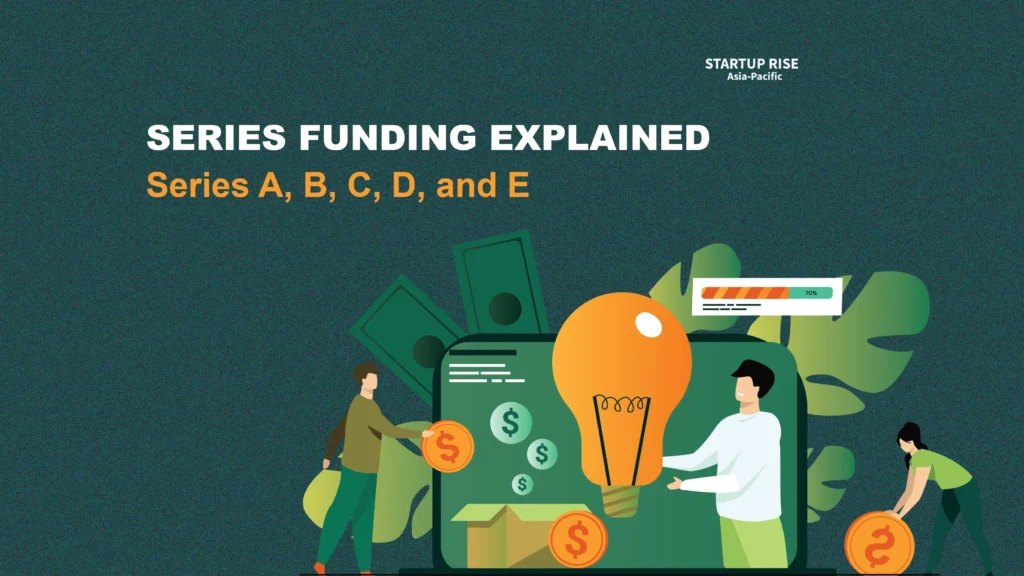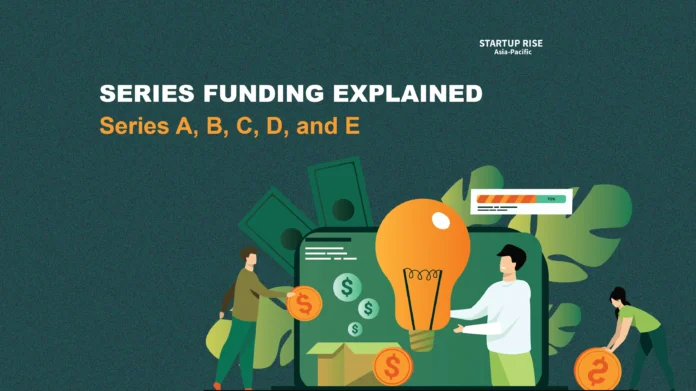
Series funding Types – A, B, C, D, E and how it works. Funding is critical for a startup’s growth, and angel investors and venture capital play a significant role in startup series funding.
STARTUP SERIES FUNDING
We will talk about startup series investment and its operation in this article. A business’s ability to grow depends on finance, and venture capital and angel investors are important sources of startup series investment. This article might assist you if you want to learn everything there is to know about series funding.
What is startup series funding?
Startups can obtain money from outside investors in exchange for ownership through a multi-round process called startup series funding. Friends, relatives, angel investors, and venture capitalists are a few examples of these investors. When a startup has little money, series investment is a common way for them to get capital. This kind of funding gives business owners the start-up capital they require while also giving investors the chance to make large profits should the venture flourish.
Startups can raise money through the issuance of equity or the purchase of a stake in the business through series funding, also referred to as equity funding. The company’s founders might not have enough money in the beginning to sustain its expansion. Series investment gives investors an ownership position in businesses while providing them with the funds they need to develop. Startups can draw in additional funding rounds thanks to their successful growth and higher value, which lessens the stock dilution for founders and early investors.
What are the different stages of series funding?
Each of the various critical phases that startup funding goes through is essential to its development. The earliest stage, known as seed funding, is when entrepreneurs, friends, family, and angel investors provide the first money needed to launch the company. This capital frequently implies a significant risk for foundational operations like research, product development, and initial operating costs because of the unproven nature of companies in the market.
Startups proceed to Series A, which is a phase centered on product development and market validation, after receiving seed funding. The goal of this round, which often includes venture investors, is to take the business past its early phases of development. Series B and Series C are later rounds that concentrate on scaling activities and extending market penetration. Outside investors provide money to the company in exchange for ownership shares during each fundraising round, which has an effect on the company’s valuation and growth trajectory.
Depending on their maturity and growth goals, startups must pass these crucial milestones. Throughout a startup’s expansion phase, investors—including venture capitalists and angel investors—are essential in giving both financial assistance and strategic direction.
Pre-seed funding
The initial phase of startup financing, known as pre-seed fundraising, takes place prior to official series funding rounds. Founders and those who support them, including friends, family, and incubators, usually invest between a few thousand and a million dollars at this phase.
This money is used by entrepreneurs to create product prototypes, study the market, and improve business plans. Entrepreneurs use this critical time to launch pilot projects and proof of concept, which set the stage for upcoming fundraising rounds. Pre-seed capital, albeit not legally classified in standard funding rounds, is essential to the initiation and validation of startup projects.
Seed funding
The first phase of external finance, known as “seed funding,” is intended to launch a business by sowing the seeds for future expansion. An average of $3.5 million is usually raised at this point. Angel investors, close friends and family, venture capital firms, and incubator programs are some of the places to find startup money. For startups that have well-defined original concepts, it is perfect as it helps them clarify their target market tactics and build the product.
Angel investors are particularly drawn to seed funding opportunities because they provide a chance to purchase shares in the firm at an early stage, frequently at the lowest valuation. Seed money is essential for launching a business that hasn’t yet made a name for itself in the market, even if it may carry a larger risk.
Series Funding Rounds
Following the seed stage, companies usually have many product prototypes and a well-defined target market when they apply for series funding rounds. Even after they have attracted initial notice and support, they will still need to submit a thorough business plan that demonstrates long-term sustainability and profit potential in order to get additional funding.
Capital is raised through series funding rounds, which include seed funding, Series A, Series B, and beyond. These rounds support various phases of the business lifecycle, from original development to business scaling. In order to obtain more substantial funding, entrepreneurs reach out to larger investors, such as venture capitalists.
Startups provide investors with regular updates on the state and performance of their businesses during the fundraising process. From seed to Series A, B, C, and beyond, funding is provided. Founders and close allies, such family and friends, usually contribute the first funding in the beginning. Next, in order to support their further expansion and development, startups go out to investors such as angel or venture capitalists.
Series A Funding
For firms looking to expand and establish a stronger position in the market, Series A funding is essential. It represents a noteworthy financing round that comes after the financial performance and business viability have been confirmed. Series A capital, which typically ranges from $2 million to $15 million, can represent the following stage of additional expansion
Startups frequently enlist accelerators for cash and mentorship in exchange for equity in order to obtain Series A funding. Building relationships with investors increases the likelihood of receiving money, thus networking with VCs and angel investors is essential.
Startups with many product prototypes, proven target markets, and a solid long-term business plan demonstrating sustainable income creation are what investors seek out.
Valuations are established during discussions by taking into account variables including historical sales, growth rates, market size, and related risks. The startup’s financial structure and projected growth trajectory are shaped by the stock investors receive in exchange for their capital, which is influenced by this valuation. A successful series of funding allows companies to grow their operations by hiring staff, reaching new markets, enhancing products, and creating efficient marketing plans
Series B funding
Unlike Series A investment, which concentrates on initial funding, Series B funding, which is the second significant financing round for startups, is more focused on scaling operations. Preferred stock is usually bought by venture capitalists in Series B, when leading companies are frequently involved. Large companies and financial institutions are examples of strategic investors that make significant contributions by offering important contacts and resources.
Series B rounds get capital in a wide range of amounts, from $5 million to $50 million.
These funds are generally used by startups to build out their infrastructure, grow their business, hire important staff, build out their sales teams, and start large-scale marketing campaigns.
About two years following Series A fundraising, startups usually look for Series B capital after showcasing notable market expansion and success. With this round, they can expand their consumer base by introducing new product lines, improving their branding, and breaking into new markets.
But Series B capital is riskier, particularly for businesses expanding into more mature sectors. In order to reduce this risk, investors can seek more equity. During Series B negotiations, founders should safeguard their equity and make sure the valuation accurately represents the business’s growth trajectory.
Series C Funding
The third stage of venture capital investment, known as series C funding, is designed to support firms’ quick expansion and growth. This stage is attended by well-established financial institutions including hedge funds, investment banks, and private equity firms because of the startup’s strong track record, substantial traction, and bright future.
Typically, series C investment falls between $30 million and $100 million. It can be used for a variety of purposes, such as expanding into new markets, advancing R&D, consolidating debt, repurchasing equity, bolstering cash reserves, and even taking out other companies.
A lot of entrepreneurs consider Series C funding to be their last round of capital before considering acquisition or going public. By now, companies are appealing to top-tier investors since they have proven to have significant revenues, a sizable client base, a solid growth trajectory, and a competent team.
Preparing the company for an acquisition, initial public offering (IPO), or large-scale expansion—often through acquisitions—is the main goal of Series C finance. Even though this is often the last investment round, some firms might look to raise money in later rounds.
Companies looking for Series C capital are not startups anymore; rather, they are established companies with devoted clientele and distinctive brand identities.
Private equity firms, hedge funds, and investment banks are drawn to Series C investments because to their low risk, proven business strategy, and significant growth potential, which might result in a valuation of $1 billion or more.
Series D Funding and Beyond
A firm usually decides to purchase another company or go public after receiving Series D funding. Its goal is to expand resources and capabilities even further, frequently as a result of unrealized potential prior to an IPO or discontent with the outcomes of Series C fundraising. Most firms opt to stay private or postpone their IPO, with few making it to Series D or above.
A Series D round’s funding, which is mostly provided by venture capitalists, can total anywhere from millions to billions of dollars. Fewer than 5% of startups make it to Series D or E, usually due to a desire to grow their business or raise money in anticipation of an IPO. On the other hand, some go for Series D or E funding because they failed to meet their goals in the last round, which leads to a “down round” in which money is raised at a reduced price, which could impede future fundraising attempts and reduce the value of the company’s stock.
Startups typically go through three or four investment rounds, depending on the state of the market and their ability to succeed. A lot of startups fail fast, most frequently following their Series A initial investment. The next typical stage for those who make it to Series C is to be ready for an IPO.investment. The next typical stage for those who make it to Series C is to be ready for an IPO.
Other types of funding
If your company isn’t a good fit for Series A, B, or C finance, there are a number of other methods for obtaining funds. By taking into account the following, startups can expand their funding sources beyond stock and venture capital:
Bootstrapping is the practice of funding early business operations with credit cards, personal savings, and assistance from friends and family while minimizing the issuance of external debt or equity.
Crowdfunding: Using a platform to raise money from a wide number of people while frequently offering features or products in exchange, proving product concepts, and expanding the client base without reducing ownership.
Loans: Getting small business loans from lenders that provide funding without giving up ownership, however debt financing may be more expensive than stock options.
Grants: Getting non-refundable money from charitable organizations or the government to assist particular projects or efforts that meet the requirements for grants.
Revenue-based financing: offers flexibility in repayment terms linked to business revenues by selling investors a portion of future profits in exchange for immediate funding. However, this type of financing may be expensive if the business expands quickly or if revenues are unpredictable.
Corporate venture capital: refers to investments made by big businesses in startups for purposes other than financial gain. These investments may offer comparable market access, resources, and experience to traditional venture capital, but they do it in different ways.
With these fundraising choices, businesses can customize their capital raising tactics according to their needs, their stage of growth, and the preferences of their investors. This helps them avoid the financial commitments and equity dilution that come with standard series investment rounds.
Conclusion
Comprehending initial investment rounds is essential for analyzing news reports and evaluating business prospects. Every time an equity round occurs, investors exchange cash for shares, putting distinct pressures on firms.
Though the risk and maturity of each profile (Seed, Series A, B, and C) varies, they all contribute to the realization of ideas. Through series finance, investors can simultaneously support their aspirations and even profit from an IPO. This information helps startups get ready for a successful launch.
FAQs
Q1. What is Series A funding for a startup?
Series A funding is important for startups that want to grow and strengthen their market presence. It signifies a significant financing round following verification of business viability and strong financial performance. Series A funding can be the next round of incremental growth.
Q2. What is a startup funding series?
Startup series funding is a multi-round process in which startups receive investment from external investors in exchange for equity. These investors may include friends, family, angel investors, and venture capitalists.
Q3. How do I get Series A funding for startups?
Startups seek Series A funding through accelerators for mentorship and equity, while networking with VCs and angels is crucial to securing investments. Investors prefer startups with established markets, multiple prototypes, and a solid long-term business plan for sustainable revenues. Successful Series A rounds enable startups to hire, expand markets, enhance products, and scale operations effectively.





